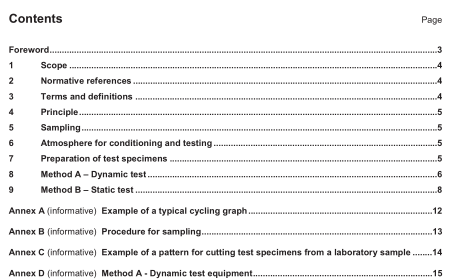BS EN 14704-2:2007 – Determination of the elasticity of fabrics — Part 2: Multiaxial tests

8 Method A – Dynamic test 8.1 Apparatus
8.1.1 CRE testing machine Metrological confirmation system of the tensile testing machine shall be in accordance with EN ISO 10012. The constant-rate-of-extension testing machine shall conform to the following.
a) The tensile testing machine shall be provided with the means for indicating or recording the force and deformation values when cycling between the original position and either a fixed load or fixed deformation. Under conditions of use, the accuracy of the apparatus shall be at least class 1 of EN ISO 7500-1. The error of the indicated or recorded maximum force at any point in the range in which the machine is used shall not exceed 1 % and the error of the indicated or recorded jaw separation shall not exceed 1 mm.
b) If recording of force or elongation is obtained by means of data acquisition boards and software, the frequency of data collection shall be at least eight per second.
c) The machine shall be capable of constant rates of distension including 20 mm/min to 500 mm/min with an accuracy of ± 10 %.
d) The machine shall be capable of variable gauge length settings including 0 to 100 mm, to an accuracy of ± 1 mm.
e) The clamping ring and probe shall be positioned with the centre in line with the applied force. The machine shall be calibrated with the clamp and probe in position. The clamping ring shall be capable of holding the test specimen without allowing it to slip and designed so that it does not cut or otherwise weaken the test specimen (see Annex D).
8.1.2 Equipment for cutting circular test specimens to the required dimensions.
8.1.3 Calibrated metal rule graduated in millimetres.
8.2 Test specimen preparation Each test specimen shall be cut (145 ± 2) mm in diameter (see Annex C). 8.3 Procedure for loading test specimen in clamping ring (see Figures D.1 and D.2)
8.3.1 Position the clamping ring (2) onto loading base (7), place the test specimen face down into the ring, the face of the fabric will be visible to the operator during the test. Next locate holding ring (4) onto the specimen and finally locking ring (5) and screw down on the specimen.
8.3.2 Set the distension rate of the specimen at 100 mm/min for woven and non-woven fabrics and 500 mm/min for knitted. 8.3.3 Fix a suitable load cell to the moving crosshead of the testing machine and then connect the probe.
8.3.4 Set the required cycling limits to cycle between the original position and 10 N (knitted and non-woven) or 50 N (woven) or 100 N (upholstery). Other loading limits can be used as agreed between parties. 8.3.5 Invert the loaded clamping ring with specimen in place onto the base unit (6) which has been attached onto the base of the testing machine (see Figure D.2).
BS EN 14704-2:2007 – Determination of the elasticity of fabrics — Part 2: Multiaxial tests